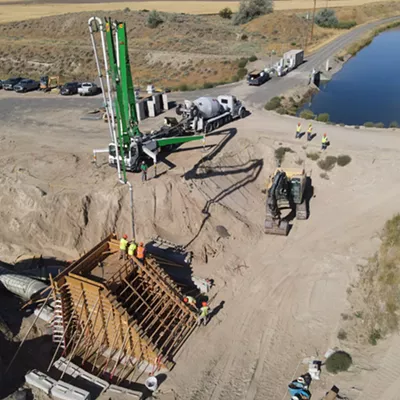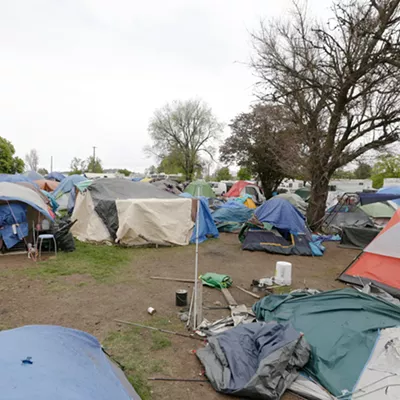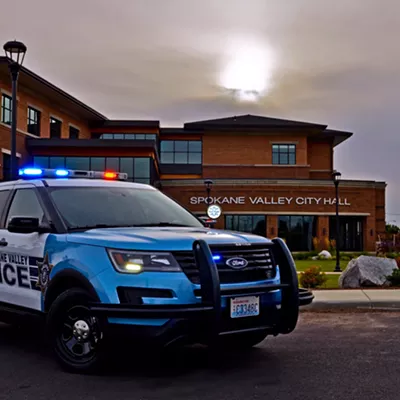But the riverbed was beautiful to Caleb Foster and Nina Buty Foster, owners of Buty Winery (pronounced "beauty") in Walla Walla, Wash. In it they saw a thriving vineyard to produce some of the best grapes in the state. The new vineyard site, just across the state line in Oregon, will likely become their estate vineyard in the next few years, once the deal closes on the small parcel of land (about 10 acres).
"We're working with an old farmer for this land," says Caleb, who had about 10 years of winemaking experience before striking out on his own. "It is less than one mile from Cayuse Vineyards [another cobblestone vineyard] and a site with a long history of crops in the area. We believe it will produce very good grapes in the future."
Buty already produces lush, delicious wines that have shown continuous improvement since their commercial start in 2000. They've managed to produce great wines on a shoestring budget with no outside financial help. That meant borrowing equipment when needed, trading skills for sites to produce the wine and keeping a sharp eye on the budget as they expanded their portfolio of wines. The wines are made from fruit in the Columbia and Walla Walla valleys, and in some cases, such as the Conner Lee Chardonnay, the wines are sourced from a single vineyard rather than a blend of vineyard fruit.
The land once produced apples and cherries, and Caleb says there is evidence that grapes were also grown in the region. But the area has low water retention with lots of rocks and little soil. The rocks will provide additional heat for the vines and excellent water drainage. Consultants say the site will not be an early-harvest site, which means the fruit will hang on the vine a little longer and come in with lower sugars and ultimately lower alcohol.
& lt;span class= "dropcap " & N & lt;/span & ina says they produce wines to go with food -- not fruit bombs that are a meal in themselves. Food is the winemakers' passion, and the wines are crafted with that in mind. They currently produce five different wines:
A 2005 Columbia Valley white wine that is a mix of 73 percent Semillon and 27 percent of Sauvignon Blanc. This wine has tropical fruit on the nose with flavors of pineapple, peach and fig in the mouth. It is a very clean and crisp wine that coats the glass and the mouth.
2005 Conner Lee Vineyard Chardonnay: This wine has pear flavors in the mouth with a splash of citrus -- lemon and orange.
2003 Rediviva of the Stones (Columbia Valley): This has sweet oak flavors in the mouth with red fruits (raspberry) and plum. The tannins are firm, but hardly noticeable in this mouth-coating wine.
2004 Rediviva of the Stones (Walla Walla Valley): Will be released in the spring of '07 -- the '03 is sold out.
2003 Caballo Blanco: a blend of cabernet franc (91 percent) and merlot (9 percent), this wine has blueberries, dark chocolate and cedar notes in the mouth, with the merlot dominating.
& lt;span class= "dropcap " & I & lt;/span & f Buty wines are indeed beautiful, the Fosters' darker humor and adventurous side emerges with their second label, Beast. That's where both Caleb and Nina experiment with grapes and blends, and Beast wine is only released through the winery. Befitting its name, the wine will be available next week, on Halloween.
"We like to refer to Beast as our very serious wild hair," says Nina. "It is a chance for us to work with different varietals and create something interesting and unique."
This year, the couple will release a 2004 Cabernet Sauvignon from the Horse Heaven Hills appellation, and a 2004 Cinsault -- a grape usually known for blending, but the Fosters liked it well enough to bottle 100 percent Cinsault. Not many wineries in the Northwest bottle the varietal. Nina describes it as an earthy wine with strawberry fruit in the mouth.
However, only about two dozen cases are available. Buty's total production is about 3,000 for Buty wines, and tiny amounts for the Beast offerings. Other than making the wine at their own location for a change, the Fosters have no immediate plans to speed up production.
"We're keeping this a family winery and have no plans to expand, despite the fact we could sell out many more wines," says Caleb.
In expanding their palates, the couple has traveled extensively around the world, working in vineyards in New Zealand and South Africa and tasting wines from Europe and other countries.
"When you travel that much, you are provided with so many more perspectives," says Nina. "You are given insight to your own strengths and what you are doing in the cellar. We are not myopic -- we do look around and see what other regions and countries are doing."
But travel for now is limited following the birth of daughter Anna-Sofia 10 months ago. The Fosters now are planning their estate vineyard and focusing on a handful of wines they know will be a gift to food and consumers.
Buty is available in the Spokane area at retail shops and in some grocery stores' wine sections.














